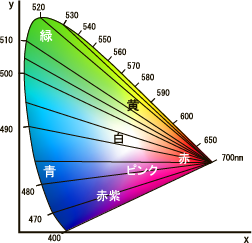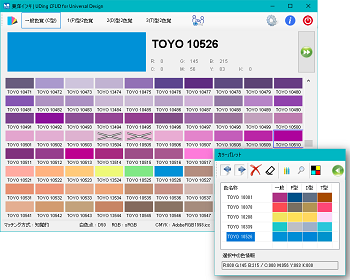Differences in vision due to differences in photoreceptor cells (color blindness)

Here, we will introduce the mechanism by which differences in color vision occur due to differences in photoreceptor cells and the differences in visual appearance.
Mechanism of seeing colors
The photoreceptor cells in the retina of the human eye have rods that sense the brightness of light and cones that sense color information.The cones include "L cones" that sense red and "M cones" that sense green. There are three types of cones: , and "S cones" that sense blue.

Differences in appearance depending on color vision type

If you graph the peak wavelengths that the human eye perceives, you can see that the peaks of L cones (red) and M cones (green) are close to each other. This is why type P and type D look relatively similar.

Trichromatic vision (formerly known as normal trichromatic vision) C (Common) type
A person with three types of cones who is diagnosed by an ophthalmologist as having normal color vision. Because it occurs most often, it is also called general color vision.

Type 1 dichromatosis
P (Protanope) type
It occurs when the "L-cone" that senses red does not function properly. It accounts for approximately 25% of congenital color blindness.

type 2 dichromatism
D (Deuteranope) type
It occurs when the "M-cone" that senses the color green does not function properly. It is the most common type, accounting for approximately 75% of congenital color blindness.

Type 3 dichromatosis
T (Trianope) type
It occurs when the S-cones, which sense blue, do not function properly. The frequency of occurrence is very rare.
Simulating the difference in vision
Colors that are difficult to distinguish and ways to make them easier to distinguish
What is a "color combination that is difficult to distinguish"?
Colors that appear the same to people with dichromatic vision line up in a straight line on an xy chromaticity diagram (a representation of the color of light in (x,y) plane coordinates). The colors on this line appear to be different colors to people with trichromatic vision, but they appear confused as the same color to people with dichromatic vision, and this is called the confusion color line.
Therefore, by slightly shifting the hue from the confusion color line, you can create a color scheme that is easy to distinguish for people with different color vision types.
Additionally, people with color blindness are said to have better contrast discrimination abilities than people with general color vision, and can create easily distinguishable color schemes by adding contrast or dithering.

Confusion color line in type 1 dichromatosis

Type 2 dichromatosis confusion color line

Confusion color line in type 3 dichromatosis
| pink | ⇔ | gray |
| light blue | ⇔ | gray |
| yellow green | ⇔ | ocher |
| Blue green | ⇔ | gray |
| light green | ⇔ | Pale orange (light orange) |
| dark brown | ⇔ | deep green |
| red | ⇔ | green |
| dark red | ⇔ | black |
| dark green | ⇔ | black |
artience solutions

Currently, we have developed "Lioatlas™ CFUD" that can create color palettes that support color universal design by applying image color conversion technology cultivated over many years, and " " that can simulate the appearance of each color vision type and convert colors compatible with CUD. Lioatlas™ Simulator" and other color management tools.
Dithering process
Dithering is generally a mechanism to minimize errors by mixing noise during data conversion.
artience group's color scheme simulation & conversion tool "Lioatlas™ Simulator" The optional function "Lioatlas™ Dither" allows you to dithering with patterns such as checkerboard patterns and stripes, so that you can minimize design changes while supporting color universal design. We respond to the need to avoid changing the hue as much as possible.

